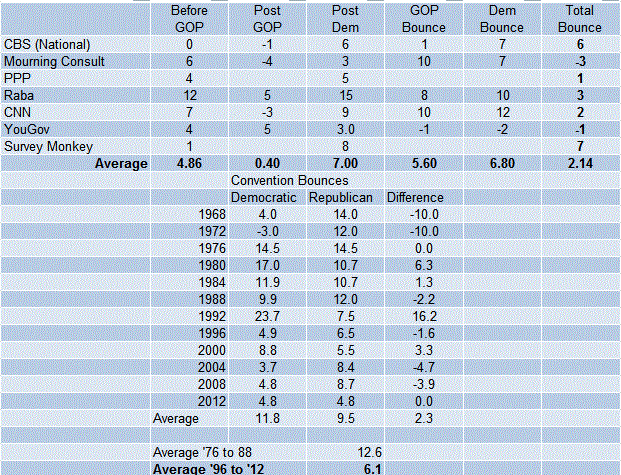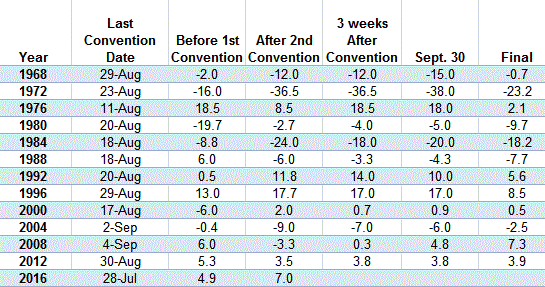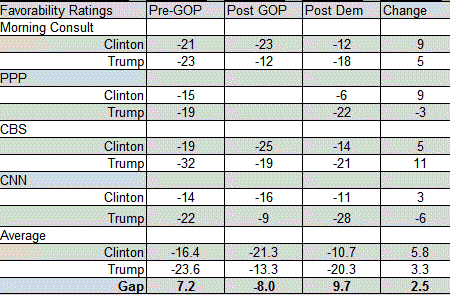Dan Guild follows up on his deep dive into the history of convention bounces. You can read his past writing for this site here and here. -promoted by desmoinesdem
On July 20th I suggested we would probably know who the next President is after the conventions are over. That post noted that since 1996 the average bounce out of a convention was 6.1 percent. Let’s look at how that compares with the bounces out of the two conventions just completed.
Essentially, the conventions were very close to the historical average. Importantly, though, Clinton appears to have picked about 2 points from where the race stood before the two conventions.
In my post two weeks ago I made the following observations:
1. In 11 of the last 12 elections the candidate leading after the last convention has won the popular vote.
2. Only one of 11 candidates who led by more than 5 points after their convention lost (Dukakis in ’88).
Clinton as of this moment in the post-convention polling leads by about 7 points. No candidate since 1952 (16 straight elections) has lost a lead that large at this point in the cycle. In 1948 polling was sparse, but there was one poll showing Truman trailing by 6 in October.
So the odds are very good that we know who the next President is: Hillary Clinton.
So I am pretty proud of the fact that history provided really good guidance on the events of the last 14 days.
As a reminder, this chart summarizes the change from post convention to final election results. The leader at this point usually wins.
BUT.
But history is not a straight line. Perhaps the most consistent thing about it is that it never fails to surprise. A reporter once asked British Prime Minister Harold McMillian what could possibly derail a government that looked to have completely won the moment. His reply (which some say is apocryphal) “Events, my dear boy, events” should be something anyone seeking to predict this election should take to heart. As of this moment it is difficult to see how Clinton loses.
And yet the very things that might make her lose are by the very nature unpredictable.
So I will flat out say I do NOT believe the odds that are touted out on certain sites. I understand them. I can even calculate them myself. As I will review in a future piece, in 4 of the 11 elections that have taken place since 1968, swings larger than Hillary Clinton’s current lead have occurred.
But that is to come.
For now I want to look at one other factor I noted in conventions: their impact on candidate favorability. The table below shows the impact of the conventions.
Clinton’s improvement in favorability ratings is larger than Trump’s. The gap in their net favorability is larger than the gap between them in trial heats. This suggests to me that the head to head polling is likely not capturing the entirety of Clinton’s advantage. Ultimately I would expect, and indeed history has shown, the advantages in favorability ratings usually translate into advantages in trial heats. There is one of other factor here worth noting. President Obama’s Approval ratings are higher than Clinton’s approval ratings. In some polling, he outperforms he in trail heats by 2 -5 points. As the pollster for PPP noted, the undecided at this point lean Democratic as a whole.
More about that next time.




